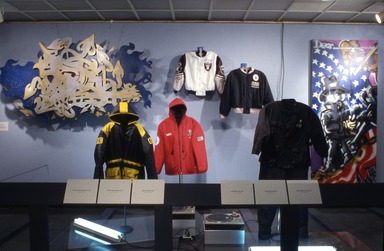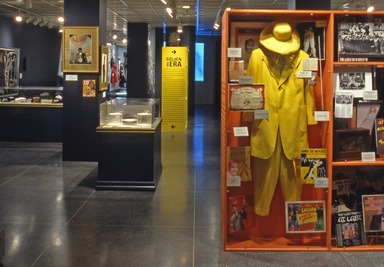Hip-Hop Nation: Roots, Rhymes and Rage
Hip-Hop Nation: Roots, Rhymes, and Rage presents the explosion of hip-hop—the most influential American cultural phenomenon of the past twenty-five years. The multimedia exhibition features over 400 items from the 1970s to the present, among them hip-hop fashions, videos, and artifacts.
Hip-Hop Nation showcases clothing and accessories worn by artists such as Afrika Bambaataa, Run-DMC, The Beastie Boys, Salt N’ Pepa, Tupac Shakur, Puff Daddy, Eminem, and Missy Elliot. Other items include manuscripts of lyrics by artists Public Enemy, Ice-T, and Arrested Development; a letter from the F.B.I. to Priority Records, expressing concern over the group N.W.A.; and audio components used by Grandmaster Flash.
The exhibition include sartifacts of Brooklyn-bred hip-hop artists, such as The Notorious B.I.G. and Jay-Z, as well as interactive D.J. stations, notable photographs and magazine covers, and music-video displays detailing hip-hop’s history and its four elements – DJing, MCing, graffiti writing, and breakdancing. Video installations created by YO-TV (Youth Organizers Television) provide (then) current teenage and young-adult perspectives on hip-hop.
Organized by the Rock and Roll Hall of Fame and Museum in Cleveland, Hip-Hop Nation is the first major exhibition of this scope and depth. The exhibition is guest curated by Kevin Powell, former senior writer for Vibe, frequent contributor to Rolling Stone, noted college lecturer, and a widely recognized authority on hip-hop culture.
Hip-Hop Nation is organized into five sections tracing the development of hip-hop. The first, “The Block Party,” introduces the different components of hip-hop. It also includes live demonstrations and computerized interactive terminals.
The second section, “The Roots,” is a look at the beginnings of hip-hop and features vintage clothing, audio equipment from the 1970s and early 1980s, a video installation, and [an] array of original party and club handbills. It includes costumes and other items related to such hip-hop pioneers as Kool Herc, Grandmaster Flash, Afrika Bambaataa, and Kurtis Blow.
“The Golden Era,” section three of the exhibition covers the mid-eighties through 1990, hip-hop’s most creative and influential period. The era produced the remarkable rhyme skills of Rakim and Slick Rick, the feminist flavor of Salt N’ Pepa, MC Lyte, Monie Love, and Queen Latifah, the agitprop poetry of Public Enemy, and the gangsta soundtrack of N.W.A. Highlights include classic photos and original album cover art; clothing from P.E.’s Chuck D, Salt N’ Pepa, Run-DMC, Queen Latifah, LL Cool J, and others, as well as original notes for De La Soul’s landmark record 3 Feet High and Rising. A video installation accompanies this section.
Section four is “Controversy: Outrage and the Rise of Gangsta Rap.” It documents the period when the subculture of gangsta rap came to dominate radio airwaves and the media’s attention. Such events as 2 Live Crew’s infamous obscenity trial and the intense criticism of Ice-T’s “Cop Killer” record (actually a rock song performed by his band, Body Count) marked hip-hop’s arrival in mainstream America. By the mid-1990s, hip-hop would lose two of its major icons to tragedy: first Tupac Shakur, then the Notorious B.I.G. were the victims of still-unsolved drive-by shootings. This section also features numerous court documents and newspaper articles, as well as artifacts from the collections of Snoop Dogg, Ice-T, N.W.A., and the Geto Boys. The last section, “Pop Goes the Culture,” acknowledges that hip-hop has now become the dominant American young culture. Since MC Hammer and Vanilla Ice in the early 1990s, hip-hop has reigned over the pop charts, along the way influencing R&B performers (TLC, R. Kelly, Mary J. Blige), rock (Rage Against the Machine, Limp Bizkit, Kid Rock), and pop (Backstreet Boyz, Britney Spears, Christina Aguilera). Hip-hop’s mainstream invasion has also transformed fashion, language, and the way that Madison Avenue markets to youth in America and worldwide. “Pop Goes the Culture” includes costumes worn by such artists as Puff Daddy, Missy Elliott, Eminem, Will Smith, The Beastie Boys, Jay-Z, and others. It also contains personal items from the estates of the Notorious B.I.G. and Tupac Shakur.
A Brief History of Hip Hop
Hip-hop was born in New York City in the early 1970s as a creative outlet for inner-city young people. As a fiscal crisis ripped through the city eliminating many social programs, these young people – mainly African American, Puerto Rican, and West Indian – threw parties on their blocks and at area clubs, used the city subways and walls as a canvas, and replaced some of New York’s gang activity with local crews like the Afrika Bambaataa-led Zulu Nation. While the Bronx is commonly credited as the actual birthplace of hip-hop, uptown Manhattan (especially Harlem), Brooklyn, Queens, Staten Island, Long Island, and northern New Jersey would all be quickly influence by this burgeoning scene.
Although there are debates about how the term “hip-hop” developed (the late Cowboy of Grandmaster Flash and The Furious Five is often cited as the originator of the term), the culture has almost from the beginning consisted of four major elements: DJing, MCing, breakdancing, and graffiti writing. Early hip-hop was largely a “throw-your-hands-in-the-air” music, taking its cues from the funk of James Brown and Parliament-Funkadelic, among other sources. The very first rap record, “King Tim III (Personality Jock),” was performed by the funk band Fatback, featuring Harlem-bred King Tim III and released in August 1979.
In the fall of 1979, Sugar Hill Gang released “Rapper’s Delight.” This song became a national and international success, and soon hip-hop pioneers like Afrika Bambaataa, Grandmaster Flash, and Kurtis Blow were recording. In the 1980s, hip-hop grew in popularity as mainstream acts like the rock band Blondie and jazz legend Herbie Hancock brought the genre to new and broader audiences. Additionally, early hip-hop films like Wild Style helped to popularize hip-hop culture. And hip-hop’s first supergroup, Run-DMC, almost single-handedly made the b-boy lifestyle a permanent part of the American pop arena.
Now a billion-dollar industry, hip-hop has transformed itself into a global youth culture, crossing racial, ethnic, gender, class, language, and geographical boundaries. Hip-hop is manifested everywhere, pushing the sales of products and turning rappers like Queen Latifah, Will Smith, Foxy Brown, Lil’ Kim, and LL Cool J into cultural icons.
Hip-Hop Nation presents this culture with all its complexities and diverse trends, including current activities, such as the “Hip-Hop For Respect” project, the hip-hop community’s response to police brutality, as led by Brooklyn’s own Mos Def.
Image credit Brooklyn Museum, 2000

